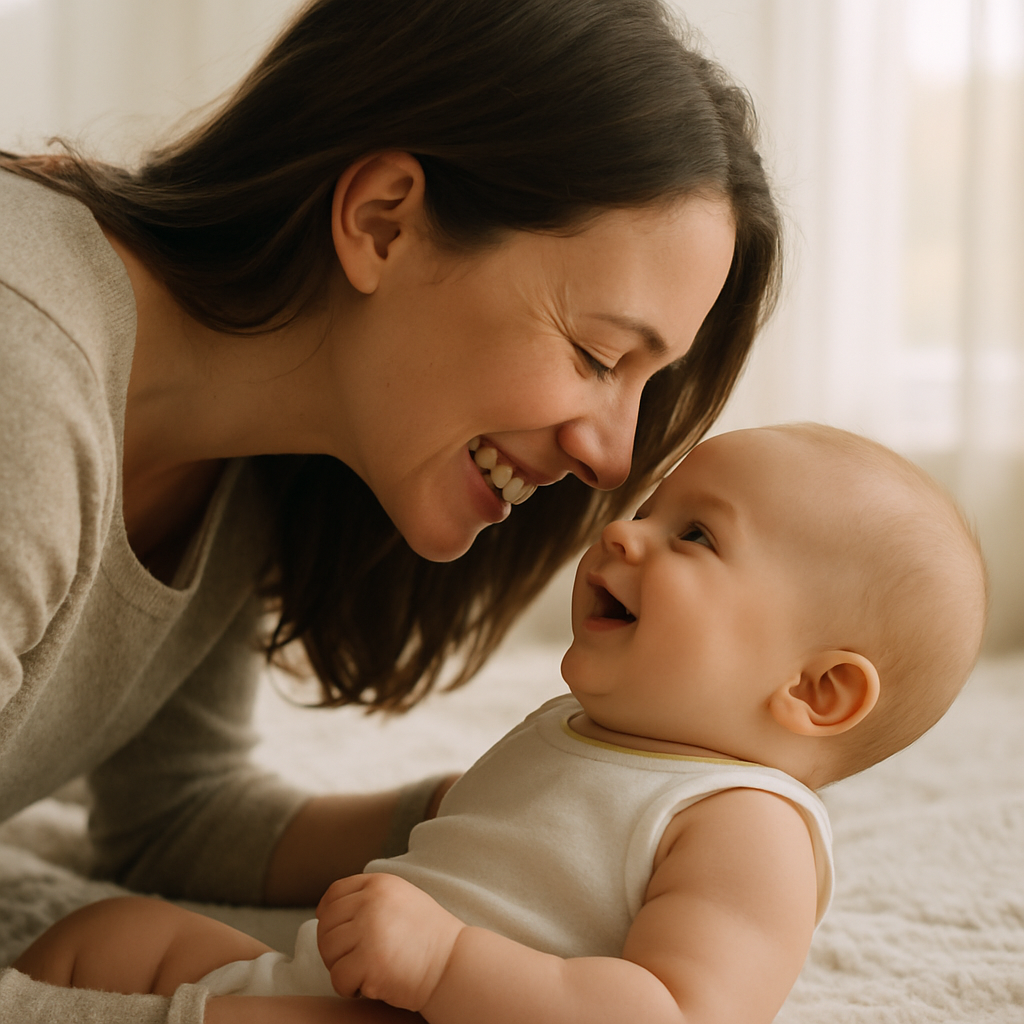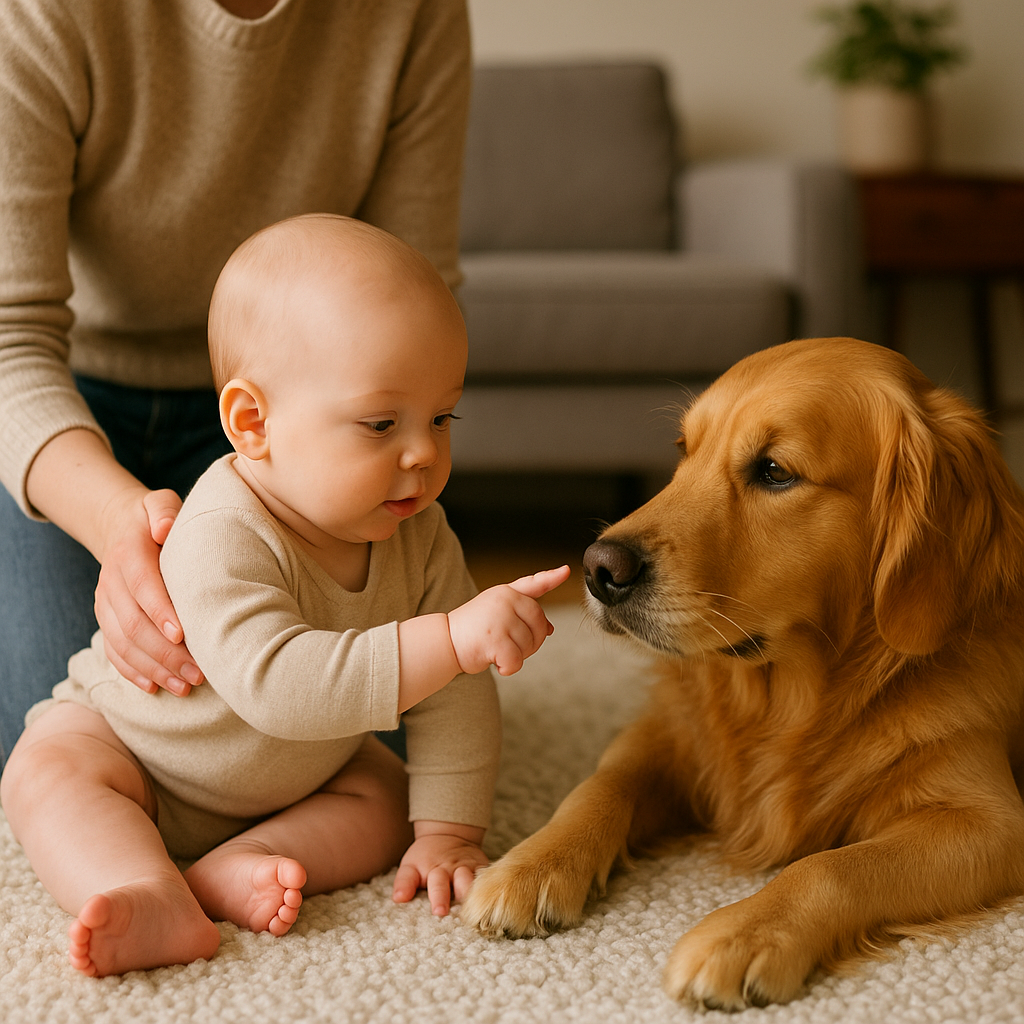Have you ever noticed your baby’s eyes widen when the family cat strolls by? Or how they squeal with delight during a game of peek-a-boo with a sibling? These aren’t just adorable moments—they’re brain-building goldmines. Research shows that by 10 months, babies with pets spend about 20% more time scanning faces (human and animal) than those without. That extra attention is wiring their social brain, thanks to daily interactions with family and furry friends alike.
- How do everyday family interactions actually build your baby’s brain?
- What unique brain boosts can pets give during the first year?
- Do family bonds and pet bonds shape the social brain in the same way?
- Quick comparison: who supplies which developmental “nutrient”?
- What risks or limits should parents know before mixing babies and pets?
- How can you turn family-pet moments into daily brain fuel?
- What myths—and open questions—still swirl around pets and baby brains?
- Your Top Questions, Answered
- Final Thoughts
How do everyday family interactions actually build your baby’s brain?
Everyday family interactions play a vital role in shaping your baby’s brain. Warm, back-and-forth exchanges with caregivers ignite neural growth within seconds. Research calls these moments “serve and return.”
- Talking and Responding: When you chat with your baby or respond to their coos and cries, you’re teaching them the basics of communication. This back-and-forth builds their understanding of language and strengthens the brain’s language centers. Explore practical ideas in Serve-and-Return.
- Reading and Singing: Sharing a story or a lullaby introduces rhythm, sounds, and words, boosting early language skills and memory.
- Play and Attention: Playing peek-a-boo or comforting them when they’re upset helps develop their social skills and emotional regulation, wiring their brain to process relationships and emotions.
- A secure attachment lowers stress hormones and boosts baseline oxytocin, giving the amygdala a “calm” signal for life. Learn more in Secure Attachment.
- Even simple routines—morning songs, bedtime kisses—act as rhythmic cues that help gray matter organize efficiently.

What unique brain boosts can pets give during the first year?
Pets can offer your baby’s brain some special advantages during their first year. Eye-tracking studies show infants with pets fixate 30 % longer on the eye region of animal faces, sharpening social-cue detection. This mirrors how bilingual settings tune the brain to multiple languages.
- Sensory Stimulation: The feel of soft fur, the sound of a purr, or the sight of a wagging tail engages your baby’s senses. These experiences help develop sensory processing skills, teaching their brain to interpret and respond to the world around them.
- Social and Emotional Growth: Watching you care for a pet can spark early lessons in empathy and responsibility. Even simple actions, like smiling at a pet’s antics, help your baby connect emotions to interactions.
- Motor Skills: Reaching out to touch a pet or trying to crawl toward them encourages fine and gross motor development, as your baby’s brain coordinates movement with curiosity.
With the right care, pets can create a rich, stimulating environment that complements family interactions and nurtures your baby’s growing brain.

Do family bonds and pet bonds shape the social brain in the same way?
Family and pet bonds both nurture the social brain, but they do so in distinct yet complementary ways. While they share some effects—like boosting emotional connection through oxytocin release—they each contribute unique elements to social and emotional development.
Both family and pet interactions activate brain regions tied to empathy and reward, such as the amygdala (emotion) and orbitofrontal cortex (reward). fMRI studies show these areas light up when people see their child or pet, suggesting both relationships foster bonding and emotional well-being. Both also trigger oxytocin, the “feel-good” hormone, which reduces stress and strengthens social ties.
Family relationships, particularly with parents and siblings, lay the foundation for complex social skills:
- Parents provide emotional security and teach language, shaping the prefrontal cortex for decision-making and social understanding.
- Siblings encourage negotiation and turn-taking, enhancing problem-solving and flexibility.
Need more face-to-face practice with humans? Check out Face-to-Face Play.
Quick comparison: who supplies which developmental “nutrient”?
| Relationship | Best at… | Bonus Brain Benefit |
|---|---|---|
| Parents | Emotional security | Stress-buffering oxytocin |
| Siblings | Negotiation, language turn-taking | Prefrontal flexibility |
| Pets | Empathy, sensory enrichment | Enhanced visual attention to living beings |
| Grandparents | Storytelling, cultural memory | Vocabulary expansion |
What risks or limits should parents know before mixing babies and pets?
Introducing pets into a baby’s environment can offer developmental benefits, but it also comes with risks and limitations that parents must manage carefully. Below, I outline the key concerns:
- Risk of Bites or Scratches: The primary concern is physical harm from pets, particularly bites or scratches. Supervised interactions reduce bite risks to below 0.5%, but unsupervised contact increases the likelihood of injury. Babies, with their unpredictable movements, may start Trafford as a pet, leading to defensive reactions.
- Allergy and Asthma Risks: Early pet exposure can lower allergy risks by 15–30% for many children, according to the American Academy of Pediatrics. However, genetic predispositions matter. If parents have a history of allergies or asthma, exposure may not be protective and could increase respiratory issues in some cases.
- Zoonotic Infections: Pets can carry germs that pose risks to babies with developing immune systems. Diseases like toxoplasmosis (from cats) or salmonella (from reptiles) are concerns. Regular vet care, including vaccinations and deworming, minimizes these risks, but parents must maintain strict hygiene, such as washing hands after pet contact.
- Pet Stress and Behavioral Issues: Babies’ loud cries or sudden movements can stress pets, potentially leading to aggression or withdrawal. Stressed pets may nip or scratch, even if typically gentle. Providing a calm, pet-only retreat space is critical to prevent agitation.
- Emotional Impact of Pet Loss: If a pet dies before a child is 3, it may confuse their understanding of object permanence (the concept that things exist even when unseen). This can lead to emotional distress if not handled sensitively. Parents should use clear, simple language, like “Buddy is gone, but we’ll always love him,” to explain loss.
Maintaining a Low-Stress Environment benefits both baby and pet.
How can you turn family-pet moments into daily brain fuel?
Family-pet moments can spark your baby’s brain development when turned into safe, intentional routines. Below are practical, science-backed ways to make these moments brain-building, keeping safety first:
- Narrate Pet Play: While your baby gently touches the pet (always supervised), say, “Soft puppy fur!” This links language acquisition and touch, strengthening the hippocampus for memory. Do this for 2 minutes during calm times, like after a nap.
- Post-Nap Pet Greeting: After naps, let a calm pet (e.g., a dog) greet your baby for 3–4 minutes. The routine builds emotional security in the amygdala, signaling safety. Use a happy tone: “Here’s Kitty!”
- Guide Gentle Petting: Help your baby pet slowly with an open hand, saying, “Nice and gentle.” This hones fine-motor skills and boosts serotonin, similar to Infant Massage. Keep it to 1–2 minutes to avoid overwhelming the pet.
- Involve Siblings: Let an older sibling show the baby how to wave at the cat, fostering joint attention and social skills in the prefrontal cortex. Supervise closely and praise teamwork for a quick 2-minute session.
Tips for Success
- Supervise Always: Prevent grabs or pet stress, keeping bite risks below 0.5% as noted in CDC, 2023.
- Choose Calm Moments: Try mid-morning or post-feeding when the baby and pet are relaxed.
- Support with Nutrition: Omega-3s (e.g., in breast milk) aid myelination, amplifying benefits.
Pair with calming strokes from Infant Massage for extra serotonin.
What myths—and open questions—still swirl around pets and baby brains?
Pets can enrich a baby’s developmental environment, but myths about their impact on brain growth often mislead parents.
Myth: Pets Automatically Make Babies Smarter
Fact: Having a pet doesn’t guarantee cognitive gain. Cognitive benefits, like enhanced memory or problem-solving, occur only in engaged households with intentional interactions.
Myth: All Pets Are Equally Beneficial for Brain Development
Fact: Most research focuses on dogs and cats, showing benefits like a 22% increase in prosocial behavior in preschoolers with dogs. Other pets, like birds or reptiles, are understudied.
Myth: Pet Exposure Always Prevents Allergies
Fact: Early pet exposure can reduce allergy risk by 15–30% for many children. However, genetic predispositions matter. If parents have allergies, exposure may not be protective and could increase asthma risk, requiring a pediatrician’s input.
Myth: Pets Teach Babies Language as Effectively as Humans
Fact: While narrating pet interactions (e.g., “Puppy says woof!”) boosts vocabulary, pets don’t match human serve-and-return interactions. Pets aid sensory skills instead.
Myth: Pets Are Always Safe with Babies
Fact: Supervised interactions reduce bite risks to below 0.5%, as per CDC, 2023, but unsupervised contact can lead to scratches or bites.
Gap: Nearly all research centers on dogs and cats. We know little about birds, rabbits, or reptiles.
Expert reminder: “Relationship quality beats mere pet presence,” says developmental psychologist Megan Mueller of Tufts University.
For a broader look at environmental choices, see Daycare vs. Stay-at-Home.
Your Top Questions, Answered
-
Can my dog sleep in the nursery?
Yes, if the dog is healthy, vaccinated, and supervised initially. A baby gate ensures safety during sleep, and unsupervised contact should be avoided to reduce risks like accidental scratches, which have an incidence below 0.5% with supervision. Start with short, monitored co-sleeping trials to build trust. For more on safe environments, see Low-Stress Environment. -
Will early pet exposure prevent allergies?
Early exposure reduces allergy risk by 15–30% for many, but genetics matter. A family history of allergies may increase asthma odds, so consult a pediatrician to assess risks. Regular pet grooming and home cleaning further lower allergen exposure. -
Do babies recognize individual pets?
By 8 months, babies can distinguish familiar pet faces. This recognition strengthens memory circuits in the hippocampus, priming social learning. Encourage consistent pet interactions to reinforce this skill, like daily supervised greetings. -
Can pets help with baby speech development?
Pets indirectly boost speech through narrated interactions. Saying “Woof, doggy!” during play builds vocabulary and turn-taking, supporting language acquisition. Narrate pet moments daily for 2–3 minutes, but human serve-and-return remains key. See How Babies Learn Emotions from Parents. -
How do pets affect baby sleep?
Calm pets can soothe babies, but excitable ones may disrupt sleep. Pet sounds may lower stress, but unpredictable pet behavior can wake infants. Keep pets out during naps until routines are stable, and use a white noise machine if needed.
For insight on how parents model feelings, visit How Babies Learn Emotions from Parents.
Final Thoughts
Loving serve-and-return interactions with family build the core of your baby’s brain, fostering neural connections critical for emotional and cognitive growth. Adding pets to these supervised routines—through a gentle pat or a playful purr—brings unique sensory and emotional richness, enhancing empathy and sensory processing. Together, these moments don’t just create joyful memories; they shape a resilient, socially adept brain, setting your child up for a lifetime of learning and connection. For more on nurturing brain development, explore Low-Stress Environment.